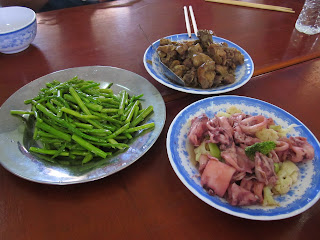We decided we wanted to get something a bit more authentic for dinner, and we soon found ourselves eating goat hotpot amongst the locals. A few of us appreciated the new culinary experience, but it was a bit too much of a culture shock for most of us.
The next morning, we enjoyed the delicious breakfast buffet at Hoang Hai Long 1 Hotel, which was filled with authentic Vietnamese dishes, Western breakfast items, and a ton of fruit.
After flying to Da Nang, we were taken to eat the local specialty: Bun Cha Ca (fishcake vermicelli). The bun cha ca was definitely a crowd favorite.
When we reached our hotel in Hue, we went next door and had our first meal at BLOOM (Because Love Overcomes Once Misfortuned). The restaurant serves as a culinary training facility for children that were once apart of ACWP (Aid for Children Without Parents), VMO’s partner organization. The food served ranges from Hue specialties to pizza and pasta. We returned to BLOOM several times while we were in Hue.
During our first full day in Hue, we tasted some small Hue dishes (Banh Ram It, Banh Nam, Banh Beo, Nem Nuong, and many others) for lunch and then had Banh Canh Ca Loc (rice noodles similar in consistency to udon with fish) for dinner.
Some of our other meals in Hue consisted of Banh Khoai (a crispy Vietnamese crepe that everyone loved), Com Hen (a rice and peanut dish with small clams in clam broth), vegetarian pho (at the temple/nursery home), and a homemade meal at one of the orphanages.
Before sending us off, Co Tran made us all Com Am Phu (literally translates to Hell Rice) with pork and very spicy peppers over rice, and then took us to eat Che (Vietnamese dessert with lots of variations).
In Hoi An, we embraced our inner tourists and tried a restaurant that was a bit more Americanized. Most of us got the snapper wrapped in banana leaf, which was the restaurant’s special. Before leaving Hoi An, we tried Cao Lau (egg noodles with pork or beef) because we heard that is where the dish originated.
Once we got back to Ho Chi Minh City, we went for more well known dishes, such as Com Tam (broken rice with grilled meat) and Banh Mi (Vietnamese sandwiches on French bread).
We spent our next few days in Ninh Thuan, where the doctors and dentists provided us with dishes that are traditionally eaten in Vietnamese homes. We had our fill of fish, vegetables, pork, and soup.
During our last night together in Ho Chi Minh City, we all ordered room service because we were not up for playing a game of Frogger with the motorcycles.
In the end, there were only five of us left in Ho Chi Minh City. We were a little sick of Vietnamese food at that point and went out to get some Pizza Hut. Interestingly, Pizza Hut is considered upscale in Vietnam, which can be seen through their fancy interior design and mocktails.
-- submitted by Anne Lieu, UC Berkeley




































